 W
WAn air classifier is an industrial machine which separates materials by a combination of size, shape, and density.
 W
WAn air purge system is used to flush electrical control equipment with clean air before it is turned on. This ensures that the functionality of the equipment is not affected or damaged by the contaminants from the surrounding environment.
 W
WBaffle spray scrubbers are a technology for air pollution control. They are very similar to spray towers in design and operation. However, in addition to using the energy provided by the spray nozzles, baffles are added to allow the gas stream to atomize some liquid as it passes over them.
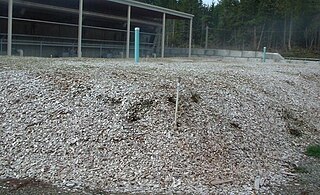 W
WBiofiltration is a pollution control technique using a bioreactor containing living material to capture and biologically degrade pollutants. Common uses include processing waste water, capturing harmful chemicals or silt from surface runoff, and microbiotic oxidation of contaminants in air.
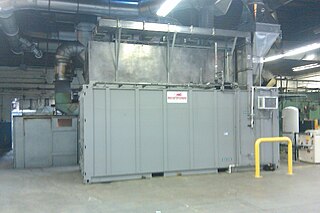 W
WA biological oxidizer is a device that uses micro-organisms to treat wastewater and the volatile organic compounds produced by commercial and industrial operations. Biological oxidation devices convert biodegradable organic compounds into carbon dioxide and water. This is a natural occurring process which differs from traditional chemical and thermal oxidizing agents and methods. Some of the more commonly used micro-organisms are heterotrophic bacteria, which play an important role in biological degradation processes. Generally, these micro-organisms are rod shaped and facultative. Biological oxidizers provide a stable environment which allows bacteria to naturally oxidize and stabilize a large number of organics in a more efficient manner. Some of the emissions that may be treated biologically include:heterocyclic compounds ; polyaromatic hydrocarbons (PAHs); pharmaceutical substances; polychlorinated biphenyls; hydrocarbons (oil); benzene, toluene, ethylbenzene, and xylene (BETEX); methyl ethyl ketone (MEK); some metals.
 W
WBLUES is the abbreviation for the German "Bremer Luft UEberwachungs System". It is a monitoring system for air pollution and is being managed by the environmental authority in the German federal state of Bremen.
 W
WA catalytic converter is an exhaust emission control device that reduces toxic gases and pollutants in exhaust gas from an internal combustion engine into less-toxic pollutants by catalyzing a redox reaction. Catalytic converters are usually used with internal combustion engines fueled by either gasoline or diesel—including lean-burn engines as well as kerosene heaters and stoves.
 W
WCold ironing, or shore connection, shore-to-ship power (SSP) or alternative maritime power (AMP), is the process of providing shoreside electrical power to a ship at berth while its main and auxiliary engines are turned off. Cold ironing permits emergency equipment, refrigeration, cooling, heating, lighting and other equipment to receive continuous electrical power while the ship loads or unloads its cargo. Shorepower is a general term to describe supply of electric power to ships, small craft, aircraft and road vehicles while stationary.
 W
WCyclonic separation is a method of removing particulates from an air, gas or liquid stream, without the use of filters, through vortex separation. When removing particulate matter from liquid, a hydrocyclone is used; while from gas, a gas cyclone is used. Rotational effects and gravity are used to separate mixtures of solids and fluids. The method can also be used to separate fine droplets of liquid from a gaseous stream.
 W
WCyclonic spray scrubbers are an air pollution control technology. They use the features of both the dry cyclone and the spray chamber to remove pollutants from gas streams.
 W
WDiesel exhaust is the gaseous exhaust produced by a diesel type of internal combustion engine, plus any contained particulates. Its composition may vary with the fuel type or rate of consumption, or speed of engine operation, and whether the engine is in an on-road vehicle, farm vehicle, locomotive, marine vessel, or stationary generator or other application.
 W
WDiesel exhaust fluid is a liquid used to reduce the amount of air pollution created by a diesel engine. Specifically, DEF is an aqueous urea solution made with 32.5% urea and 67.5% deionized water. DEF is consumed in selective catalytic reduction (SCR) that lowers the concentration of nitrogen oxides in the diesel exhaust emissions from a diesel engine.
 W
WA diesel particulate filter (DPF) is a device designed to remove diesel particulate matter or soot from the exhaust gas of a diesel engine.
 W
WAn ejector or jet venturi scrubber is an industrial pollution control device, usually installed on the exhaust flue gas stacks of large furnaces, but may also be used on any number of other air exhaust systems. This type of technology is a part of the group of air pollution controls collectively referred to as wet scrubbers. Although operating in similar ways to a venturi scrubber the ejector venturi is not driven by the flow of process gas and instead the energy is derived from the high-pressure spray of liquid from a nozzle, allowing the scrubber to also act as a vacuum ejector and draw process gas through the device without external assistance.
 W
WAn electrostatic precipitator (ESP) is a filtration device that removes fine particles, like dust and smoke, from a flowing gas using the force of an induced electrostatic charge minimally impeding the flow of gases through the unit.
 W
WIn internal combustion engines, exhaust gas recirculation (EGR) is a nitrogen oxide (NO x ) emissions reduction technique used in petrol/gasoline and diesel engines. EGR works by recirculating a portion of an engine's exhaust gas back to the engine cylinders. This dilutes the O2 in the incoming air stream and provides gases inert to combustion to act as absorbents of combustion heat to reduce peak in-cylinder temperatures. NO x is produced in high temperature mixtures of atmospheric nitrogen and oxygen that occur in the combustion cylinder, and this usually occurs at cylinder peak pressure. Another primary benefit of external EGR valves on a spark ignition engine is an increase in efficiency, as charge dilution allows a larger throttle position and reduces associated pumping losses.
 W
WFlue-gas desulfurization (FGD) is a set of technologies used to remove sulfur dioxide from exhaust flue gases of fossil-fuel power plants, and from the emissions of other sulfur oxide emitting processes such as waste incineration.
 W
WA fluidized bed concentrator (FBC) is an industrial process for the treatment of exhaust air. The system uses a bed of activated carbon beads to adsorb volatile organic compounds (VOCs) from the exhaust gas. Evolving from the previous fixed-bed and carbon rotor concentrators, the FBC system forces the VOC-laden air through several perforated steel trays, increasing the velocity of the air and allowing the sub-millimeter carbon beads to fluidize, or behave as if suspended in a liquid. This increases the surface area of the carbon-gas interaction, making it more effective at capturing VOCs.
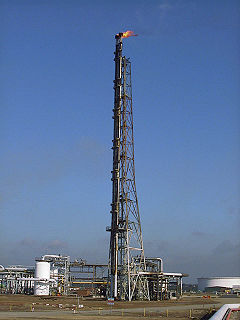 W
WA gas flare, alternatively known as a flare stack, is a gas combustion device used in industrial plants such as petroleum refineries, chemical plants and natural gas processing plants. They are also common at oil or gas extraction sites having oil wells, gas wells, offshore oil and gas rigs and landfills.
 W
WA hopper is a large, pyramidal or cone shaped container used in industrial processes to hold particulate matter or flow-able material of any sort, like dust, gravel, nuts, seeds etc. and can then dispense these from the bottom when needed. In some specialized applications even small metal or plastic assembly components can be loaded and dispensed by small hopper systems. In the case of dust collection hoppers the dust can be collected from expelled air. Hoppers for dust collection are often installed in groups to allow for a greater collection quantity. Hoppers are used in many industries to hold material until it is needed, such as flour, sugar or nuts for food manufacturing, food pellets for livestock, crushed ores for refining, etc. Dust hoppers are employed in industrial processes that use air pollution control devices such as dust collectors, electrostatic precipitators, and baghouses/fabric filters. Most hoppers are made of steel.
 W
WIQAir is a Swiss air quality technology company, specializing in protection against airborne pollutants, developing air quality monitoring and air cleaning products. IQAir also operates AirVisual, a real-time air quality information platform. As of February 2020, it had around 500 employees worldwide, 150 of them in China, and its most important markets were Asia and North America.
 W
WA LO NOx burner is a type of burner that is typically used in utility boilers to produce steam and electricity.
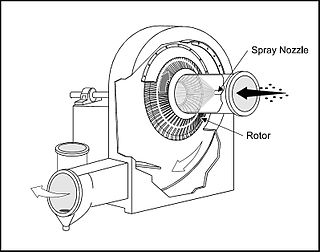 W
WMechanically aided scrubbers are a form of pollution control technology. This type of technology is a part of the group of air pollution controls collectively referred to as wet scrubbers.
 W
WA regenerative thermal oxidizer (RTO) is a piece of industrial equipment used for the treatment of exhaust air. The system is a type of thermal oxidizer that uses a bed of ceramic material to absorb heat from the exhaust gas. It then uses this captured heat to preheat the incoming process gas stream and destroy air pollutants emitted from process exhaust streams at temperatures ranging from 815 °C to 980 °C
 W
WRoutine flaring, also known as Production flaring, is a method and current practice of disposing of large unwanted amounts of associated petroleum gas (APG) during crude oil extraction. The gas is first separated from the liquids and solids downstream of the wellhead, then released into a flare stack and combusted into earth's atmosphere; usually in an open diffusion flame. Where performed, the unwanted gas has been deemed unprofitable, and may be referred to as stranded gas, flare gas, or simply as "waste gas". Routine flaring is not to be confused with safety flaring, maintenance flaring, or other flaring practices characterized by shorter durations or smaller volumes of gas disposal.
 W
WA spray tower is gas-liquid contactor used to achieve mass and heat transfer between a continuous gas phase and a dispersed liquid phase. It consists of an empty cylindrical vessel made of steel or plastic, and nozzles that spray liquid into the vessel. The inlet gas stream usually enters at the bottom of the tower and moves upward, while the liquid is sprayed downward from one or more levels. This flow of inlet gas and liquid in opposite directions is called countercurrent flow.
 W
WTaikisha Global Limited, commonly known as Taikisha or TKS, is a Japanese multinational corporation headquartered in Tokyo, Japan, that designs, fabricates, installs, and commissions large-scale heating, ventilation, and air conditioning (HVAC) systems for large infrastructures and industrial process equipment.
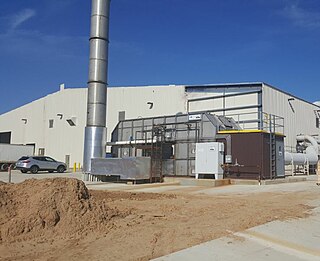 W
WA thermal oxidizer is a process unit for air pollution control in many chemical plants that decomposes hazardous gases at a high temperature and releases them into the atmosphere.
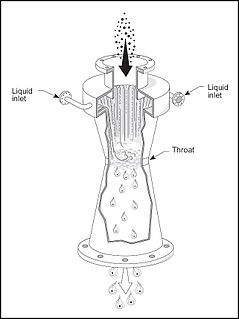 W
WA venturi scrubber is designed to effectively use the energy from a high-velocity inlet gas stream to atomize the liquid being used to scrub the gas stream. This type of technology is a part of the group of air pollution controls collectively referred to as wet scrubbers.